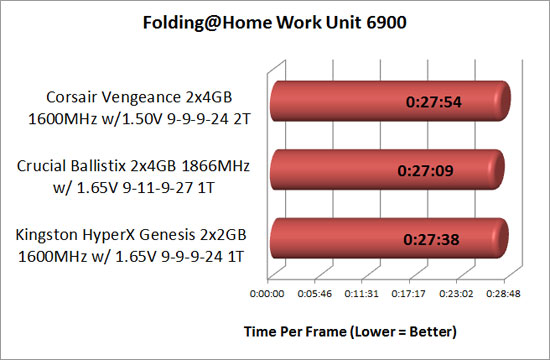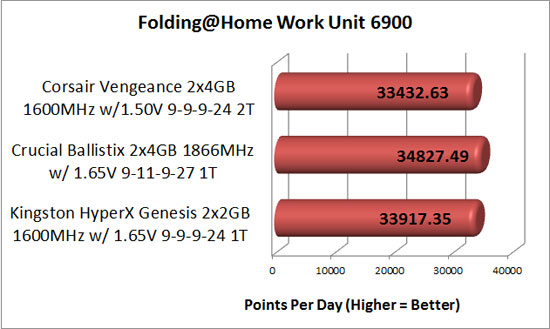Corsair Vengeance 8GB DDR3 1600 CL9 Memory Kit Review
Folding@Home Scientific Computation
Folding@Home (http://folding.stanford.edu/) is a distributed computing project, which means people throughout the world download the Folding@Home client software and run it. When combined, the processing power of the Folding@Home project is one of the worlds most powerful supercomputers. The project is used to study protein folding, misfolding, and related diseases, giving researchers the tools to better understand diseases such as Alzheimer’s, ALS, Mad Cow (BSE), CJD, Huntington’s, Parkinson’s disease, and many Cancers. Anyone can run the Folding@Home client software and use their spare CPU and GPU power to contribute to a good cause. After the client software finishes a molecular simulation, called a Work Unit (WU), the donor receives points based on the amount of processing power required to run the WU and how quickly the WU was completed. Many Folding@Home contributors join together to form teams, creating a lot of friendly competition between teams and team members to compile the most points in the project.
To benchmark Folding@Home we are using an application developed by a group of Folding@Home contributors, led by a user named musky. Muskys benchmark uses a particular set of work units to allow a measurable, consistent comparison between benchmark runs. Since our CPU is a 4 core, 8 thread CPU with hyperthreading, we will be benchmarking the multithreaded SMP “bigadv” work unit number 6900. Bigadv (which stands for big advanced) units are designed for CPUs that can handle 8 simultaneous threads or more. Bigadv units are larger than standard SMP units so they can effectively use a multithreaded CPUs processing power to complete the scientific work as quickly as possible and produce the most points per day for the donor. We will be measuring the computation time needed to finish one percent or “frame” of the work unit (time per frame or “TPF”), as well as the points generated per day (“PPD) if a work unit is completed at this speed.


The 6900 bigadv work unit is a project that heavily uses both CPU and memory, so performance is impacted by each component in the system. Here we see that each frame of our 6900 work unit is completed 16 seconds slower than the Hyperx RAM and 45 seconds slower than the Ballistix, which translates into approximately 500 fewer points per day compared to the Hyperx or 1400 fewer points per day than the Ballistix.
With the computation-heavy tasks completed, lets see how this kit fares under a gaming workload.

Comments are closed.